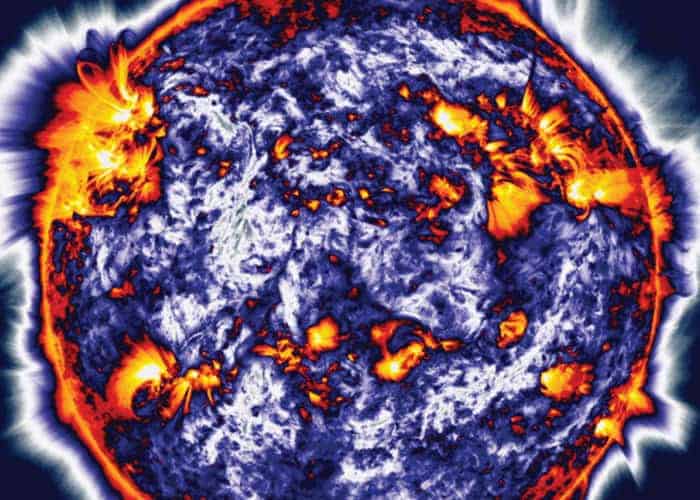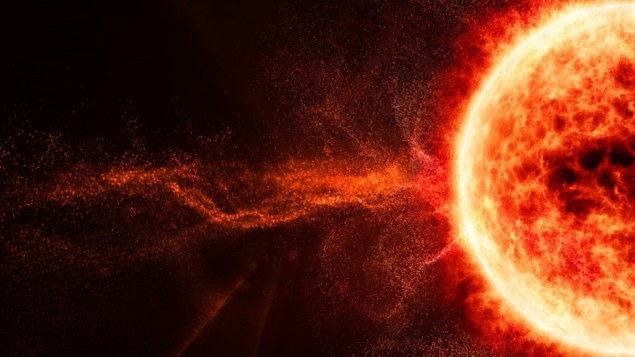Supercomputer simulations reveal how the Sun accelerates charged particles
06 Oct 2022
Hot stuff: solar flares are often associated with increased particle emissions from the Sun. (Courtesy: AdobeStock/kittiphat/180260458)
Researchers in the US have used supercomputers to gain insights into the origins of the solar wind. This is a flux of high-energy particles from the Sun that can damage satellites, threaten astronauts and even disrupt electrical and electronic systems on Earth.
Emissions of these charged particles are generally hard to predict because they are the result of complex nonlinear processes occurring in the Sun’s corona – the outer atmosphere of our star. The corona is an extremely hot plasma of ionized particles that cannot be reproduced in a controlled laboratory environment. Now, scientists at Columbia University in New York City have developed a method for predicting these events with supercomputers.
“Since we only have a limited number of measures of the plasma properties in the vicinity of the Sun, there are significant uncertainties in the knowledge of the physical properties of the plasma,” says Luca Comisso, co-author with Lorenzo Sironi of a report that describes the research. “These uncertainties are dramatically amplified by nonlinear processes, like shocks, magnetic reconnection and turbulence.”
The uncertainty of the initial conditions of the plasma, combined with the complexity of the nonlinear processes that are involved in the acceleration of the solar particles, make this a hard problem to solve. Thus, an approach that relies heavily on new high-performance computing (HPC) methods was used.
Unique in its success
Of course, HPC is not a panacea that allows the user to receive the answer to any question they ask. People have tried – and failed – to use supercomputing to solve this problem before. Comisso and Sironi’s attempt was unique in its success.
One problem that scientists have struggled with was to explain how the high-energy particles are accelerated from the lower thermal energy of the plasma. If some particles are first accelerated by an unknown process, certain plasma processes like shocks can further accelerate these particles to the energies that threaten satellites and astronauts. The challenge is to understand that initial acceleration.
“The key unresolved problem here was to understand how some particles could start gaining energy from ‘scratch’,” says Comisso. “A major possibility was to look into the effects of turbulence in the plasma since the plasma is expected to be in a turbulent state in the Sun’s atmosphere. To analyse this possibility and see if it really works, one needs to solve complex nonlinear equations.”
Complex calculation
Solving these equations demands HPC resources and the duo relied on the particle-in-cell method to describe the process of particle acceleration in a turbulent plasma. To simplify a complex calculation, this process follows the trajectories of electrons and ions in self-consistent electromagnetic fields computed on a fixed computational grid.
To simplify the problem, previous studies employed approximations that muddied the end results. Comisso says that their latest work was uniquely able to show that turbulence in the Sun’s outer atmosphere provides the initial acceleration. Furthermore, their result was achieved using a rigorous method that did not employ previous approximations.
The large-scale simulations for this work were performed on NASA’s Pleiades supercomputer at NASA and the Cori supercomputer at the US’s National Energy Research Scientific Computing Center. In both machines, the researchers ran particle-in-cell code using 50,000–100,000 central processing units (CPUs) and about 1500 nodes for each simulation. This substantial computing resource was needed to keep track of the nearly 200 billion particles that were involved in each simulation.
Protecting space exploration
This research looks set to play a vital role in boosting our understanding of the radiation that poses a threat to astronauts and spacecraft.READ MORE

“These high-energy particles pose risks to humans that are outside the protective cover of the Earth’s magnetosphere,” says Comisso. “Essentially, the Sun goes through phases of strong activity which can give rise to large solar energetic particle events, with a significant intensity of high energy protons. The large intensity of high energy protons is a radiation hazard to the exposed humans. Large radiation doses put astronauts at a significant increase of cancer risk and possibly death.”
However, the implications of this research reach beyond that. As Comisso points out, the Sun is not the only astrophysical object that can be studied with this method. For example, particles are accelerated in the proximity of other celestial objects such as neutron stars and black holes.
“I think we only scratched the surface of what supercomputer simulations can tell us about how particles can be energized in a turbulent plasma,” says Comisso.
The research is described in The Astrophysical Journal Letters.
Kevin Jackson is a science writer based in the US
from physicsworld.com 20/10/2022

Δεν υπάρχουν σχόλια:
Δημοσίευση σχολίου